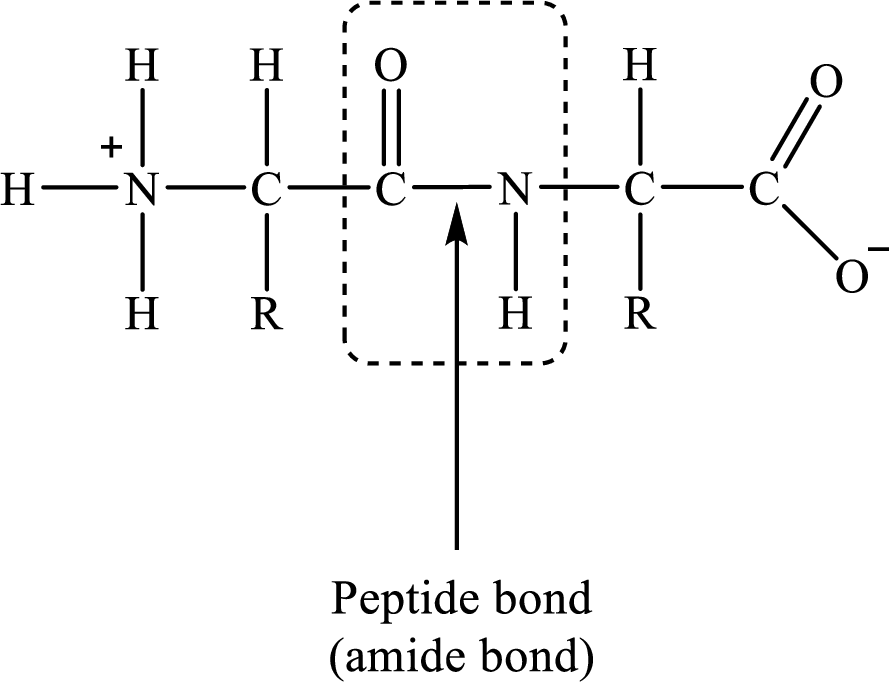
GENERAL,ORGANIC,+BIOCHEMISTRY(LL)-PKG
10th Edition
ISBN: 9781260699227
Author: Denniston
Publisher: MCGRAW-HILL HIGHER EDUCATION
expand_more
expand_more
format_list_bulleted
Concept explainers
Question
Chapter 18, Problem 18.65QP
Interpretation Introduction
Interpretation:
The rigidity in structure of protein because of peptide bond has to be explained.
Concept Introduction:
The peptide bond is an amide bond between

Expert Solution & Answer
Want to see the full answer?
Check out a sample textbook solution
Students have asked these similar questions
Can I get help on drawing my arrows
Can I get helpp drawing my arrows
Which of the m/z values corresponds to the base peak in the mass spectrum shown?
100
80
A. 45
B. 44
C. 29
D. 15
Intensity
20
0
10 20
30 40
B-
m/z
-8
50
E. 30
Which of the m/z values correspond to the molecular ion for the compound shown?
A. 18
B. 82
OH
C. 100
D. 102
E. 103
Chapter 18 Solutions
GENERAL,ORGANIC,+BIOCHEMISTRY(LL)-PKG
Ch. 18.2 - Write the one-letter and three-letter...Ch. 18.2 - Prob. 18.2QCh. 18.3 - Write the structure of each of the following...Ch. 18.3 - Write the structure of each of the following...Ch. 18.3 - Write the structure of each of the following...Ch. 18.7 - Describe the four levels of protein structure.
Ch. 18.7 - Prob. 18.6QCh. 18.9 - Prob. 18.7QCh. 18.9 - Prob. 18.8QCh. 18.11 - Prob. 18.9Q
Ch. 18.11 - How does extremely low pH cause proteins to...Ch. 18.12 - Prob. 18.11QCh. 18.12 - Prob. 18.12QCh. 18 - Prob. 18.13QPCh. 18 - Prob. 18.14QPCh. 18 - Prob. 18.15QPCh. 18 - Prob. 18.16QPCh. 18 - Prob. 18.17QPCh. 18 - Prob. 18.18QPCh. 18 - Prob. 18.19QPCh. 18 - Prob. 18.20QPCh. 18 - Prob. 18.21QPCh. 18 - Prob. 18.22QPCh. 18 - Describe the basic general structure of an...Ch. 18 - Prob. 18.24QPCh. 18 - Prob. 18.25QPCh. 18 - Prob. 18.26QPCh. 18 - Prob. 18.27QPCh. 18 - Prob. 18.28QPCh. 18 - Prob. 18.29QPCh. 18 - Prob. 18.30QPCh. 18 - Prob. 18.31QPCh. 18 - Prob. 18.33QPCh. 18 - Prob. 18.63QPCh. 18 - Prob. 18.64QPCh. 18 - Prob. 18.65QPCh. 18 - Prob. 18.66QPCh. 18 - Prob. 18.67QPCh. 18 - Prob. 18.68QPCh. 18 - Prob. 18.69QPCh. 18 - Prob. 18.70QPCh. 18 - Prob. 18.71QPCh. 18 - Prob. 18.72QPCh. 18 - Prob. 18.73QPCh. 18 - Prob. 18.74QPCh. 18 - Carbon monoxide binds tightly to the heme groups...Ch. 18 - Prob. 18.76QPCh. 18 - Prob. 18.77QPCh. 18 - Prob. 18.78QPCh. 18 - Prob. 18.79QPCh. 18 - Prob. 18.80QPCh. 18 - Prob. 18.81QPCh. 18 - Prob. 18.82QPCh. 18 - Prob. 18.85QPCh. 18 - Prob. 18.86QPCh. 18 - Prob. 18.87QPCh. 18 - Prob. 18.88QPCh. 18 - Prob. 18.89QPCh. 18 - Prob. 18.90QPCh. 18 - Prob. 18.91QPCh. 18 - Prob. 18.92QPCh. 18 - Prob. 18.93QPCh. 18 - Prob. 18.94QPCh. 18 - Prob. 18.95QPCh. 18 - Prob. 18.96QPCh. 18 - Why is it necessary to mix vegetable proteins to...Ch. 18 - Prob. 18.98QPCh. 18 - Prob. 18.99QPCh. 18 - Prob. 18.100QPCh. 18 - Prob. 1MCPCh. 18 - Consider the Chapter Map, and explain the...Ch. 18 - Tardigrades, also known as water bears, are...Ch. 18 - Calculate the length of an α-helical polypeptide...Ch. 18 - Proteins involved in transport of molecules or...Ch. 18 - The α-keratin of hair is rich in the amino acid...Ch. 18 - Calculate the number of different pentapeptides...
Knowledge Booster
Learn more about
Need a deep-dive on the concept behind this application? Look no further. Learn more about this topic, chemistry and related others by exploring similar questions and additional content below.Similar questions
- Please explain how to calculate the pH.arrow_forwardI'm having trouble with converting lewis diagrams into VSEPR diagrams. I currently have this example of C2BrCl3 which I want to turn into a lewis structure, but I'm not sure what steps I need to do in order to do so. I have the table written down, however, there's two central atoms so what would I do? There seems to be 4 electron domains on the carbon atom and no lone pairs so it would seem like this shape would be tetrahedral. Here's what I have now. Thanks!arrow_forwardWe discussed the solid phase resin using in peptide synthesis. Provide a mechanism, for its formation. DRAW THE MECHANISM.arrow_forward
- (a) 21.8 Name the following compounds. & (b) Br (e) O₂N. (h) H (c) Br (d) NH2 ☑N Br H ہیں Ph (g) OMe бл .0-0.e 21.9 Draw a structural formula for each compound. (a) 2,3-Dinitrotoluene (c) Diphenylmethanol (e) p-Nitroaniline (b) 3-Propylanisole (d) m-Propylphenol (f) Pentabromobenzenearrow_forwardIs this the major product of this reaction?arrow_forwardPlease helparrow_forward
arrow_back_ios
SEE MORE QUESTIONS
arrow_forward_ios
Recommended textbooks for you
 ChemistryChemistryISBN:9781305957404Author:Steven S. Zumdahl, Susan A. Zumdahl, Donald J. DeCostePublisher:Cengage Learning
ChemistryChemistryISBN:9781305957404Author:Steven S. Zumdahl, Susan A. Zumdahl, Donald J. DeCostePublisher:Cengage Learning ChemistryChemistryISBN:9781259911156Author:Raymond Chang Dr., Jason Overby ProfessorPublisher:McGraw-Hill Education
ChemistryChemistryISBN:9781259911156Author:Raymond Chang Dr., Jason Overby ProfessorPublisher:McGraw-Hill Education Principles of Instrumental AnalysisChemistryISBN:9781305577213Author:Douglas A. Skoog, F. James Holler, Stanley R. CrouchPublisher:Cengage Learning
Principles of Instrumental AnalysisChemistryISBN:9781305577213Author:Douglas A. Skoog, F. James Holler, Stanley R. CrouchPublisher:Cengage Learning Organic ChemistryChemistryISBN:9780078021558Author:Janice Gorzynski Smith Dr.Publisher:McGraw-Hill Education
Organic ChemistryChemistryISBN:9780078021558Author:Janice Gorzynski Smith Dr.Publisher:McGraw-Hill Education Chemistry: Principles and ReactionsChemistryISBN:9781305079373Author:William L. Masterton, Cecile N. HurleyPublisher:Cengage Learning
Chemistry: Principles and ReactionsChemistryISBN:9781305079373Author:William L. Masterton, Cecile N. HurleyPublisher:Cengage Learning Elementary Principles of Chemical Processes, Bind...ChemistryISBN:9781118431221Author:Richard M. Felder, Ronald W. Rousseau, Lisa G. BullardPublisher:WILEY
Elementary Principles of Chemical Processes, Bind...ChemistryISBN:9781118431221Author:Richard M. Felder, Ronald W. Rousseau, Lisa G. BullardPublisher:WILEY

Chemistry
Chemistry
ISBN:9781305957404
Author:Steven S. Zumdahl, Susan A. Zumdahl, Donald J. DeCoste
Publisher:Cengage Learning

Chemistry
Chemistry
ISBN:9781259911156
Author:Raymond Chang Dr., Jason Overby Professor
Publisher:McGraw-Hill Education

Principles of Instrumental Analysis
Chemistry
ISBN:9781305577213
Author:Douglas A. Skoog, F. James Holler, Stanley R. Crouch
Publisher:Cengage Learning

Organic Chemistry
Chemistry
ISBN:9780078021558
Author:Janice Gorzynski Smith Dr.
Publisher:McGraw-Hill Education

Chemistry: Principles and Reactions
Chemistry
ISBN:9781305079373
Author:William L. Masterton, Cecile N. Hurley
Publisher:Cengage Learning

Elementary Principles of Chemical Processes, Bind...
Chemistry
ISBN:9781118431221
Author:Richard M. Felder, Ronald W. Rousseau, Lisa G. Bullard
Publisher:WILEY
Biomolecules - Protein - Amino acids; Author: Tutorials Point (India) Ltd.;https://www.youtube.com/watch?v=ySNVPDHJ0ek;License: Standard YouTube License, CC-BY